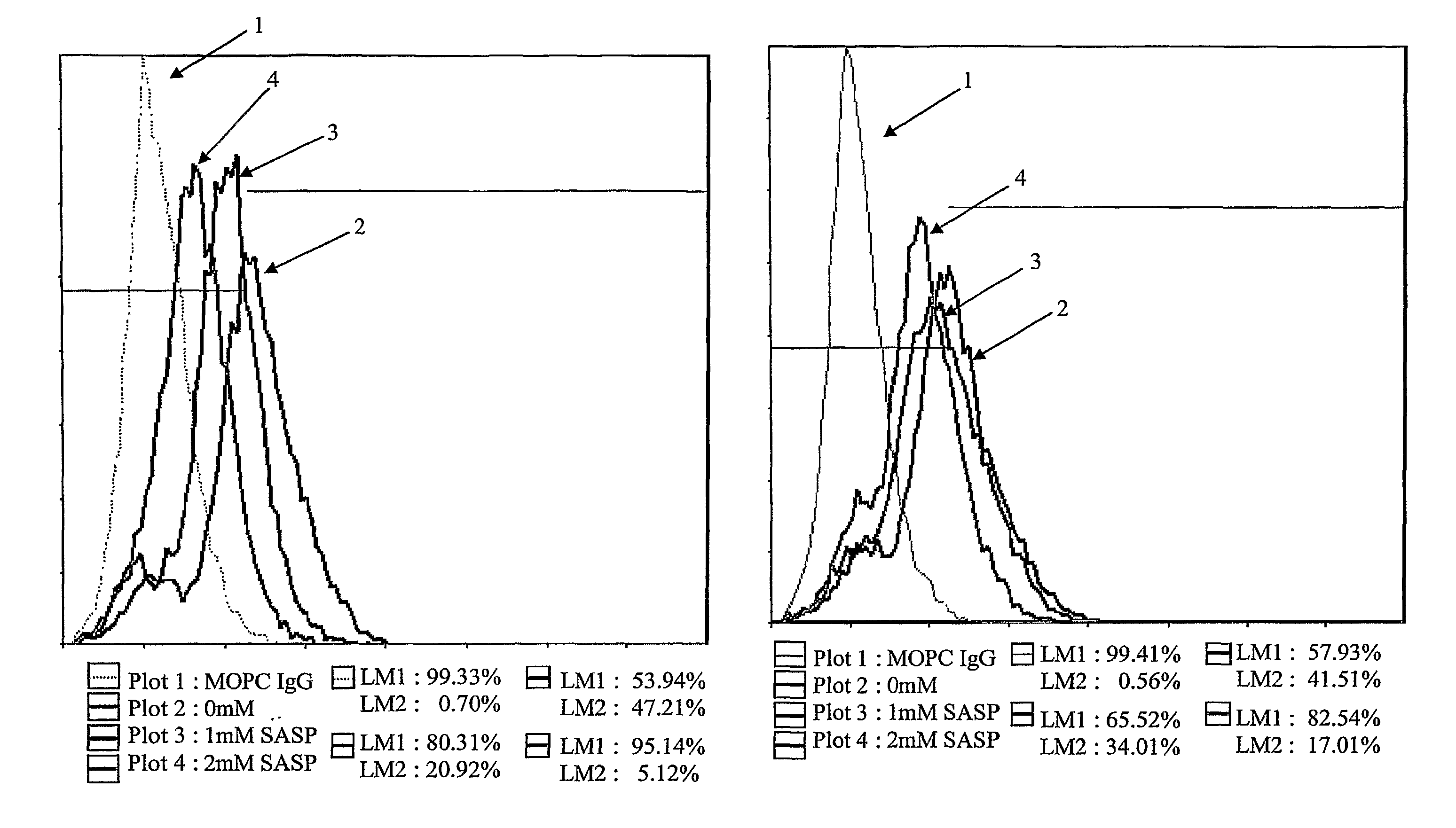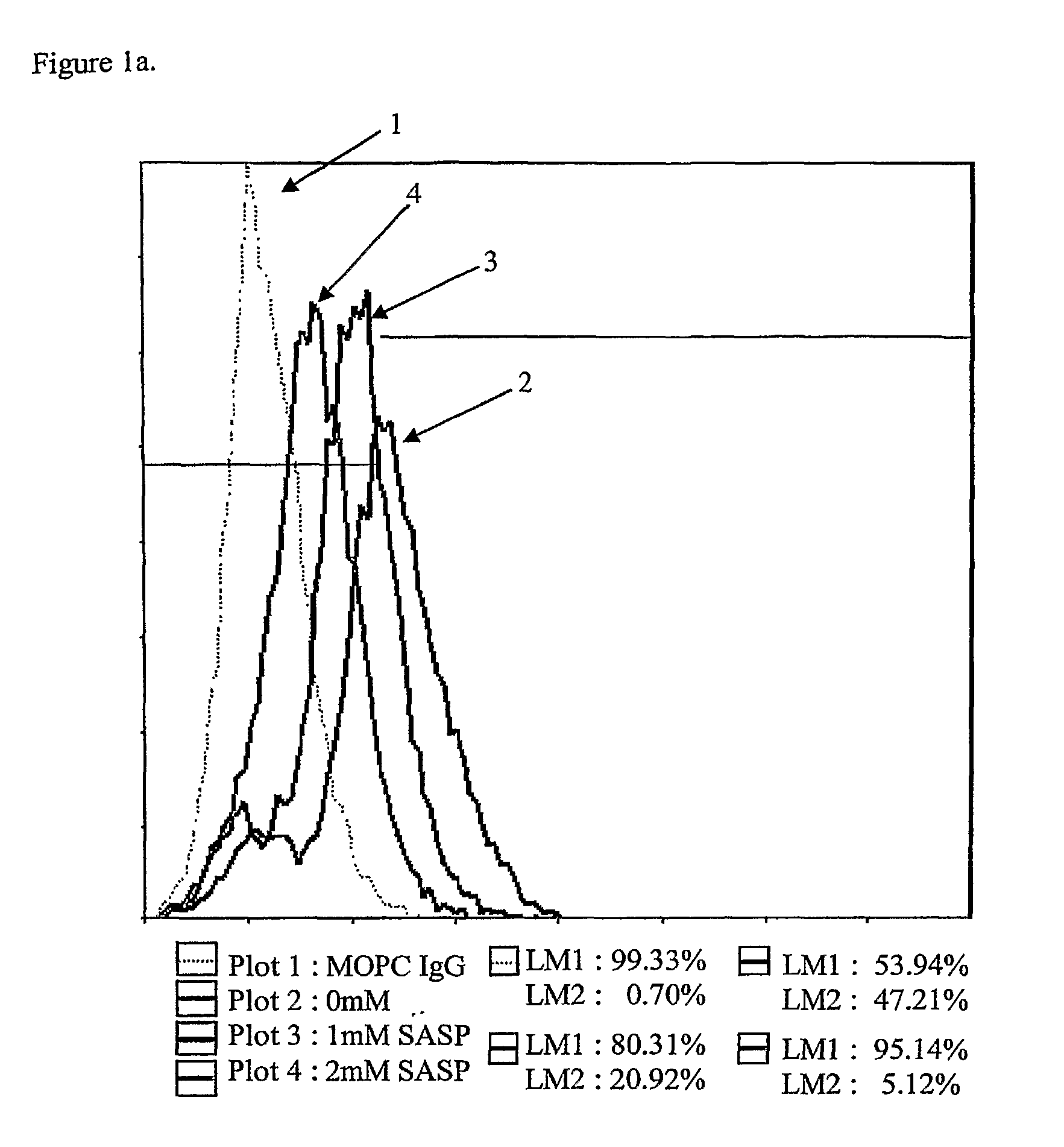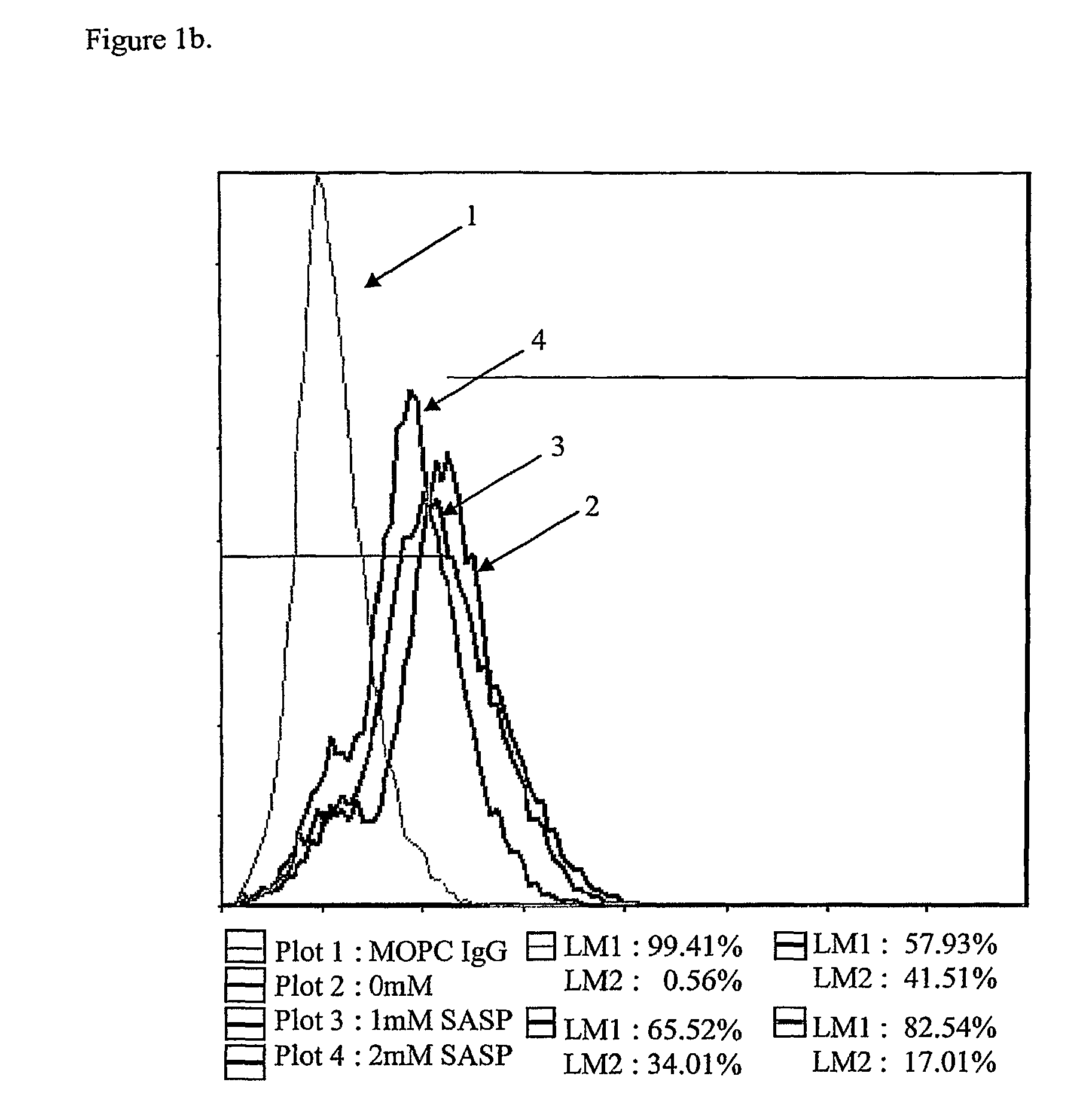Chemoprevention of colorectal cancer by mesalamine/sulfasalazine
a technology of mesalamine and sulfasalazine, which is applied in the direction of peptides, drug compositions, medical preparations, etc., can solve the problems that the mechanism by which these chemotherapeutic agents operate is not fully understood, and achieve the effect of reducing the level of tc22
- Summary
- Abstract
- Description
- Claims
- Application Information
AI Technical Summary
Benefits of technology
Problems solved by technology
Method used
Image
Examples
example 1
Fluorescent Activated Cell Sorter (FACS)
[0058]LS180 colon cancer cells were incubated with 0, 1 mM, and 2 mM of 5-ASA, SASP, and SP in Serum Free Media (SFM) for 2 hrs, 4 hrs, and 24 hrs. Dishes were washed with 10 ml PBS 3 times. Cells were detached with 0.25% trypsin-EDTA and collected. All cells were >90% viable.
[0059]The cells were washed and then fixed by using 4% paraformaldehyde for 5 minutes. Cells were washed 2 times. Cells were then resuspended and the first antibody was added: MOPC IgM(0.5 mg / mL) 1 μl (1:100), MOPCIgG(0.5 mg / mL) 1 μl (1:100), CG3 IgM(2.4 mg / mL) 1 μL of (2+3 μL Buffer) (1:250) for hTM5, TC22-4 IgG(30 mg / mL) 1 μL of (1+9 uL Buffer) (1:1000) for TC22. The suspension was incubated at 4° C. for 30 minutes, shaken and washed (2 times) with 30 vol. of PBS / 0.5 BSA / 2 mm EDTA.
[0060]The second antibody was added: 1 μl tube (1:100) Cy2 (Cyanine)-conj. G-α-M IgM or Cy2 (Cyanine)-conj. G-α-M IgM, then incubated at 4° C. for 30 minutes, shaken and washed (2 times) with ...
example 2
Reverse Transcriptase PCR(RT-PCR)
[0062]The expression levels of TC22 and hTM5 genes in LS180 cells were measured using semi quantitative RT-PCR (Perkin Elmer Gene Amp PCR system 9700). RNA was isolated from cells using RNeasy micro kit (Qiagen Inc.). RNA was eluted in a final volume of 18 ul. 11 μl of RNA was converted to first strand cDNA by reverse transcriptase in a 20 μl reaction using random hexamers and MLV reverse transcriptase (Invitrogen Inc, California). PCR reactions were carried out in 50 μl for 35 cycles using Taq polymerase (Invitrogen Inc, Carlsbad, Calif.). 4 μl of first strand cDNA was used to amplify TC22 gene, whereas 1 μl was used to amplify 18S RNA as a control. 18 μl of PCR products were analyzed on 1.5% agarose gel. The amount of PCR product for each sample was compared with that for 18S. The ratio of intensity for TC22 or hTM5 gene to that of 18S was quantified using Kodak EDAS290 gel documentation system. This ratio was used as a measure of the relative expr...
example 3
Microarray Analysis
[0064]The initial single microarray analysis following exposure of LS180 cells with 200 mM of 5-ASA for 4 hours and 24 hours demonstrates both amplification and suppression of a number of genes when compared with the 5-ASA untreated LS180 cells, as shown in Table II:
[0065]
TABLE IIChanges in gene expression when comparedwith 5-ASA untreated cellsNumber of genes up->194regulated:Up-regulated by 2 logs:CIRBP, PCK1, DEX28, LOC284926,LCMT2, ZNF214, PARS2, HSPC105,ZNF499, ZNF75A, CR8F9, BGL11, PHF17,MFG3, 1F1T2, AHSA2, TRIM59, ZNF529,C20orf18, OSGEPL1, ELAC1, 2NF13,PPAP2B, ZNF302, FLJ21125Number of genes>385down-regulated:Down-regulated by 2 logs:Family 1, MATF, ZBTB1, NR4A2, GEM,HSZFP36, BCL6, SERTAD1, SSL1D1,SPRY4, SUl1, PLK2
[0066]Up-regulated genes include various genes related to transcription, regulation of transcription, regulation of apoptosis, protein biosynthesis, zinc finger protein, immune response, heat shock activator protein, and 5 protein. Down-regulated ...
PUM
| Property | Measurement | Unit |
|---|---|---|
| volume | aaaaa | aaaaa |
| concentration | aaaaa | aaaaa |
| size | aaaaa | aaaaa |
Abstract
Description
Claims
Application Information
 Login to View More
Login to View More - R&D
- Intellectual Property
- Life Sciences
- Materials
- Tech Scout
- Unparalleled Data Quality
- Higher Quality Content
- 60% Fewer Hallucinations
Browse by: Latest US Patents, China's latest patents, Technical Efficacy Thesaurus, Application Domain, Technology Topic, Popular Technical Reports.
© 2025 PatSnap. All rights reserved.Legal|Privacy policy|Modern Slavery Act Transparency Statement|Sitemap|About US| Contact US: help@patsnap.com



